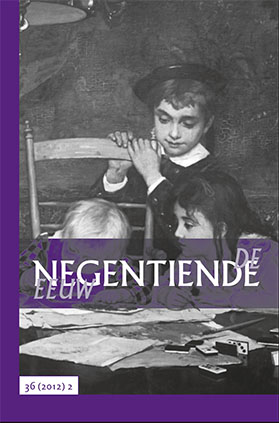Jan Dirk BaetensKunst als eeuwige jeugd. Originaliteit en schepping in de affaire Frédéric Van de Kerkhove (1862-1873) 81-103
Abstract (EN)
Art’s eternal youth. Originality and creation, and the case of Frédéric van der Kerkhove (1862-1873).This article discusses the controversy around Frédéric Van de Kerkhove, an infirm artistic child genius whose work created a sensation in the 1870s. The existence of the wonder boy was revealed shortly after his premature death in 1873, at the age of ten, when claims were made that he had produced hundreds of brilliant and stunningly original landscape paintings, which made him one of the greatest masters of all times. A campaign was mounted to exhibit his work, followed, however, by a polemic in which non-believers cried fraud whilst believers reconstructed the boy’s life along the Vasarian tropes of the precocious child genius. On a deeper level, the controversy revolved around issues of originality and influence, convention and naïve artistic instinct. For his supporters, the young and unlearned painter embodied, in a proto-modernist twist, the autonomous principle of artistic creation itself: a primitive creative force independent of time and place, training and influence; a mythic creative principle ingrained in nature itself, spontaneously budding as the birth of life itself.
Jasper JansVaderlandse geschiedenis en de
participerende burger. Onderwijs in burgerschap in het midden van de negentiende eeuw 104-119
participerende burger. Onderwijs in burgerschap in het midden van de negentiende eeuw 104-119
Abstract (EN)
Citizenship education in the middle of the nineteenth century. National history and the participating citizen.Studies of nineteenth-century Dutch discourses of citizenship tend to focus on political, legal and literary discussions. This article aims to broaden the scope of the research field, by analysing models of ‘good citizenship’ that informed Dutch national history education in the middle of the nineteenth century. When we focus on schoolbooks and other didactic instruments, it becomes clear that around 1860 a new type of history education emerged that moved away from a passive notion of citizenship, towards an idea centred on civic self-awareness and active participation of the Dutch in societal life.
Toos StrengMaakten vrouwen de dienst uit? Vrouwelijke romanauteurs in Nederland, 1790-1899. Cijfers en beeldvorming 120-147
Abstract (EN)
Female novelists in the Netherlands, 1790-1899. Facts, figures and popular images.Both present-day literary historians and nineteenth-century critics agree that between 1790 and 1899, the absolute and relative number of female novelists in the Netherlands increased. They tend to describe this increase in strong, and when it comes to the nineteenth-century critics, often negative terms. This research shows there was indeed a numerical and percentage growth of novels written by female authors, but the trend was definitely not linear and there were huge differences between the percentage contribution of Dutch, English, French and German female writers. So why then this discrepancy between, on the one hand, a very slow and modest change and, on the other hand, this often vehement contemporary resistence against female novelists? This can be understood against the background of the professionalization of authorship after 1850 and the changing status of the novel as a literary genre. With the steady rise of the novel’s status, the prevailing sentiment among literary critics was that the novel was too important to be left to women writers. Therefore, when at the end of the nineteenth century the output of novels written by women reached a certain critical level, the female novel was treated as a separate category and put in a place of her own, outside the most highly valued literary domain.
Boekzaal der geleerde wereld 148-160
- Jürgen Osterhammel, Die Verwandlung der Welt. Eine Geschichte des 19. Jahrhunderts. München: C.H. Beck, 2009. (Peter van Dam)
- P. Brusse en W.W. Mijnhardt, Towards a new template for Dutch history. De-urbanization and the balance between city and countryside. Zwolle: Waanders, 2011. (Joost Jonker)
- Wilfried Uitterhoeve, Koning, keizer, admiraal. 1810: De ondergang van het Koninkrijk Holland. Nijmegen: Vantilt 2010. (Eveline Koolhaas-Grosfeld)
- Auke van der Woud, Koninkrijk vol sloppen. Achterbuurten en vuil in de negentiende eeuw. Amsterdam: Bert Bakker, 2010. (Christianne Smit)
- Henk Gras, m.m.v. Harry van Vliet en Bennie Pratasik, ‘Een stad waar men zich koninklijk kan
vervelen’. De modernisering van de theatrale vermakelijkheden buiten de schouwburg in Rotterdam,
circa 1770-1860. Hilversum: Verloren, 2009. (Sylvia Alting van Geusau) - Liesbet Nys, De intrede van het publiek. Museumbezoek in België 1830-1914. Leuven: Universitaire Pers Leuven 2012. (Lieske Tibbe)
- Greet Draye, Laboratoria van de natie. Literaire genootschappen in Vlaanderen, 1830-1914. Nijmegen:
Vantilt, 2009. (Rick Honings) - Christophe Verbruggen, Schrijverschap in de Belgische belle époque. Een sociaal-culturele geschiedenis.
Nijmegen: Vantilt, 2009. (Lieske Tibbe) - Sanne Parlevliet, Meesterwerken met ezelsoren. Bewerkingen van literaire klassiekers voor kinderen,
1850-1950. Hilversum: Verloren 2009. (Frits Booy) - C.J. Aarts en M.C. van Etten, 175 jaar Nijgh & Van Ditmar. Nimmer dralend, 1837–2012. Amsterdam: Nijgh & Van Ditmar, 2012. (Dick Welsink)

